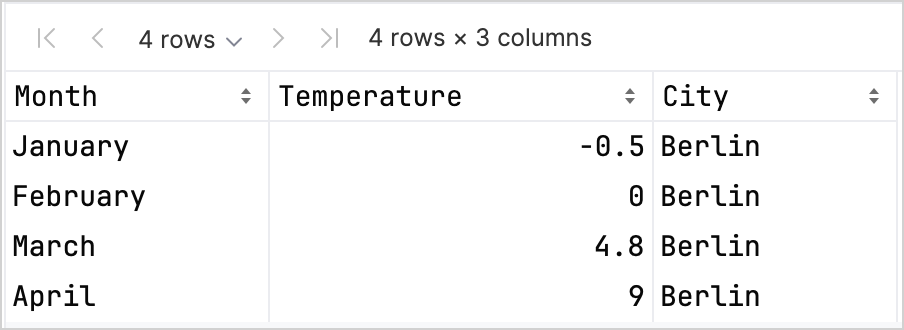Kandy를 사용한 Kotlin Notebook의 데이터 시각화
Kotlin은 강력하고 유연한 데이터 시각화를 위한 올인원 솔루션을 제공하여, 복잡한 모델에 뛰어들기 전에 데이터를 표현하고 탐색하는 직관적인 방법을 제공합니다.
이 튜토리얼에서는 Kandy 및 Kotlin DataFrame 라이브러리와 함께 Kotlin Notebook을 사용하여 IntelliJ IDEA에서 다양한 차트 유형을 생성하는 방법을 보여줍니다.
시작하기 전에
Kotlin Notebook은 기본적으로 IntelliJ IDEA에 번들로 제공되고 활성화되어 있는 Kotlin Notebook 플러그인에 의존합니다.
Kotlin Notebook 기능이 제공되지 않는다면 플러그인이 활성화되어 있는지 확인하세요. 자세한 내용은 환경 설정을 참조하세요.
새 Kotlin Notebook 생성:
File | New | Kotlin Notebook을 선택하세요.
Notebook에서 다음 명령을 실행하여 Kandy 및 Kotlin DataFrame 라이브러리를 임포트합니다.
kotlin%use kandy %use dataframe
DataFrame 생성
시각화할 레코드를 포함하는 DataFrame을 생성하는 것으로 시작합니다. 이 DataFrame은 베를린, 마드리드, 카라카스 세 도시의 월별 평균 기온 시뮬레이션 수치를 저장합니다.
Kotlin DataFrame 라이브러리의 dataFrameOf() 함수를 사용하여 DataFrame을 생성합니다. Kotlin Notebook에서 다음 코드 스니펫을 실행합니다.
// The months 변수는 1년 12개월 목록을 저장합니다
val months = listOf(
"January", "February",
"March", "April", "May",
"June", "July", "August",
"September", "October", "November",
"December"
)
// The tempBerlin, tempMadrid, and tempCaracas 변수는 각 월별 기온 값 목록을 저장합니다
val tempBerlin =
listOf(-0.5, 0.0, 4.8, 9.0, 14.3, 17.5, 19.2, 18.9, 14.5, 9.7, 4.7, 1.0)
val tempMadrid =
listOf(6.3, 7.9, 11.2, 12.9, 16.7, 21.1, 24.7, 24.2, 20.3, 15.4, 9.9, 6.6)
val tempCaracas =
listOf(27.5, 28.9, 29.6, 30.9, 31.7, 35.1, 33.8, 32.2, 31.3, 29.4, 28.9, 27.6)
// The df 변수는 월, 기온 및 도시 기록을 포함하는 세 개의 열로 구성된 DataFrame을 저장합니다
val df = dataFrameOf(
"Month" to months + months + months,
"Temperature" to tempBerlin + tempMadrid + tempCaracas,
"City" to List(12) { "Berlin" } + List(12) { "Madrid" } + List(12) { "Caracas" }
)처음 네 행을 살펴봄으로써 새 DataFrame의 구조를 탐색합니다.
df.head(4)DataFrame에는 Month, Temperature, City의 세 가지 열이 있는 것을 볼 수 있습니다. DataFrame의 처음 네 행에는 1월부터 4월까지 베를린의 기온 기록이 포함되어 있습니다.

Kandy 및 Kotlin DataFrame 라이브러리를 함께 사용할 때 타입 안전성을 높이는 데 도움이 되는 열의 레코드에 접근하는 다양한 옵션이 있습니다. 자세한 내용은 접근 API를 참조하세요.
라인 차트 생성
이전 섹션의 df DataFrame을 사용하여 Kotlin Notebook에서 라인 차트를 만들어 보겠습니다.
Kandy 라이브러리의 plot() 함수를 사용합니다. plot() 함수 내에서 차트 유형(이 경우 line)과 X축 및 Y축의 값을 지정합니다. 색상과 크기를 사용자 정의할 수 있습니다.
df.plot {
line {
// X축과 Y축에 사용되는 DataFrame 열에 접근합니다
x(Month)
y(Temperature)
// 카테고리에 사용되는 DataFrame 열에 접근하고 이 카테고리에 대한 색상을 설정합니다
color(City) {
scale = categorical("Berlin" to Color.PURPLE, "Madrid" to Color.ORANGE, "Caracas" to Color.GREEN)
}
// 선의 크기를 사용자 정의합니다
width = 1.5
}
// 차트의 레이아웃 크기를 사용자 정의합니다
layout.size = 1000 to 450
}결과는 다음과 같습니다.
포인트 차트 생성
이제 df DataFrame을 포인트(산점도) 차트로 시각화해 봅시다.
plot() 함수 내에서 points 차트 유형을 지정합니다. X축과 Y축의 값과 df 열의 범주형 값을 추가합니다. 차트에 제목을 포함할 수도 있습니다.
df.plot {
points {
// X축과 Y축에 사용되는 DataFrame 열에 접근합니다
x(Month) { axis.name = "Month" }
y(Temperature) { axis.name = "Temperature" }
// 포인트의 크기를 사용자 정의합니다
size = 5.5
// 카테고리에 사용되는 DataFrame 열에 접근하고 이 카테고리에 대한 색상을 설정합니다
color(City) {
scale = categorical("Berlin" to Color.LIGHT_GREEN, "Madrid" to Color.BLACK, "Caracas" to Color.YELLOW)
}
}
// 차트 제목을 추가합니다
layout.title = "Temperature per month"
}결과는 다음과 같습니다.
바 차트 생성
마지막으로, 이전 차트와 동일한 데이터를 사용하여 도시별로 그룹화된 바 차트를 만들어 보겠습니다. 색상에는 16진수 코드도 사용할 수 있습니다.
// 도시별로 그룹화합니다
df.groupBy { City }.plot {
// 차트 제목을 추가합니다
layout.title = "Temperature per month"
bars {
// X축과 Y축에 사용되는 DataFrame 열에 접근합니다
x(Month)
y(Temperature)
// 카테고리에 사용되는 DataFrame 열에 접근하고 이 카테고리에 대한 색상을 설정합니다
fillColor(City) {
scale = categorical(
"Berlin" to Color.hex("#6F4E37"),
"Madrid" to Color.hex("#C2D4AB"),
"Caracas" to Color.hex("#B5651D")
)
}
}
}결과는 다음과 같습니다.
다음 단계
- Kandy 라이브러리 문서에서 더 많은 차트 예제를 탐색해 보세요
- Lets-Plot 라이브러리 문서에서 더 고급 플로팅 옵션을 탐색해 보세요
- Kotlin DataFrame 라이브러리 문서에서 데이터 프레임 생성, 탐색 및 관리에 대한 추가 정보를 찾아보세요
- 이 YouTube 비디오에서 Kotlin Notebook의 데이터 시각화에 대해 자세히 알아보세요
